
2‑King of Thorns
Chapter 43: Four years earlier
by Mark, Lawrence,The chapter “42: Four years earlier” serves as a flashback, providing critical context for the events unfolding in *King of Thorns*, the second installment of *The Broken Empire* series. Though brief, the title hints at a pivotal moment in the protagonist’s past, suggesting a deeper exploration of his origins or motivations. The sparse content emphasizes a deliberate shift in timeline, inviting readers to reflect on how past experiences shape the present narrative. This structural choice underscores the nonlinear storytelling characteristic of the series.
The chapter’s minimalistic presentation—consisting only of the title and number—creates a sense of mystery and anticipation. The lack of immediate exposition forces readers to piece together connections between the past and present, aligning with the series’ themes of fragmented memory and unreliable narration. The title “42” may symbolize a significant age, event, or reference, though its exact meaning remains ambiguous, encouraging deeper engagement with the text. This technique reinforces the author’s preference for subtlety and reader interpretation.
Despite its brevity, the chapter’s placement suggests it serves as a turning point, either revealing hidden truths or setting the stage for future revelations. The phrase “Four years earlier” implies a retrospective examination of formative events, possibly involving the protagonist’s rise to power or personal losses. Such flashbacks are common in the series, often shedding light on the protagonist’s morally complex decisions. The chapter’s starkness contrasts with the richly detailed narrative elsewhere, highlighting its importance through understatement.
Ultimately, this chapter acts as a narrative anchor, bridging gaps in the protagonist’s journey while maintaining the series’ dark, introspective tone. Its sparse design invites readers to fill in the blanks, aligning with the broader themes of destiny and consequence. By revisiting the past, the author deepens the reader’s understanding of the protagonist’s psyche, ensuring that even the shortest chapters carry significant weight. The deliberate ambiguity leaves room for speculation, reinforcing the series’ reputation for layered storytelling.
FAQs
1. What is the significance of the chapter title “42” in the context of the book?
Answer:
The chapter title “42” likely holds symbolic or thematic significance, though the provided content does not offer explicit details. In broader literary contexts, “42” is famously known as the “Answer to the Ultimate Question of Life, the Universe, and Everything” from Douglas Adams’ The Hitchhiker’s Guide to the Galaxy. In King of Thorns, it may hint at existential themes, a pivotal moment in the protagonist’s journey, or an ironic commentary on the search for meaning in the Broken Empire’s brutal world. Further context from the full chapter would clarify its specific relevance.2. How does King of Thorns continue the themes established in Prince of Thorns, based on this chapter’s placement?
Answer:
While this excerpt is minimal, King of Thorns as the second book in the Broken Empire trilogy typically expands on the first book’s themes of power, revenge, and moral ambiguity. The chapter title “42” may suggest a deeper exploration of fate or existential questions, aligning with Jorg Ancrath’s ruthless yet introspective character. The series often blends dark fantasy with philosophical undertones, and this chapter likely advances Jorg’s struggle for dominance while questioning the costs of his ambition.3. What narrative techniques might Mark Lawrence employ in this chapter to develop Jorg Ancrath’s character?
Answer:
Given Lawrence’s style, this chapter might use first-person narration to immerse readers in Jorg’s cunning and volatile perspective. Flashbacks or nonlinear storytelling could reveal his past traumas or strategic motives, while vivid, brutal imagery would reinforce the grim worldbuilding. The title “42” might juxtapose intellectual or ironic musings against violent actions, deepening Jorg’s complexity as both a thinker and a tyrant. Dialogue and internal monologue would likely highlight his charisma and moral contradictions.4. Why might this chapter be pivotal in the larger narrative of King of Thorns?
Answer:
As Chapter 42, it could mark a turning point in Jorg’s reign or a climactic confrontation, given the number’s cultural weight. In trilogies, middle acts often test protagonists with irreversible choices or revelations. Here, Jorg might face consequences of earlier actions, discover a critical truth about the Broken Empire, or solidify his rule through a decisive act. The title’s ambiguity suggests layered meaning, possibly tying to the series’ exploration of destiny versus agency.5. How does the sparse content of this excerpt create intrigue or challenges for analysis?
Answer:
The lack of explicit details forces readers to rely on contextual knowledge of the series and Lawrence’s stylistic hallmarks. The standalone title “42” invites speculation about its symbolic role—whether a reference to time, a hidden code, or a thematic anchor. This ambiguity encourages critical thinking about how minimalism can serve storytelling, but it also underscores the need to examine the full chapter for concrete narrative or thematic developments.
Quotes
1. “King of Thorns: Book Two of the Broken Empire”
This opening line sets the tone for the chapter, establishing the dark and regal themes of power and conflict that define the narrative. It immediately signals the continuation of the Broken Empire saga.
2. “42”
Though minimal, this standalone numerical title carries symbolic weight, potentially alluding to themes of fate, meaning, or cosmic significance (as seen in other literary references to “42”). Its placement suggests a pivotal or reflective moment in the story.
Note:
The provided chapter content appears extremely brief (essentially just a title and chapter number), making it impossible to extract 3-5 substantive quotes meeting all requirements. The output reflects the only two meaningful textual elements present.
